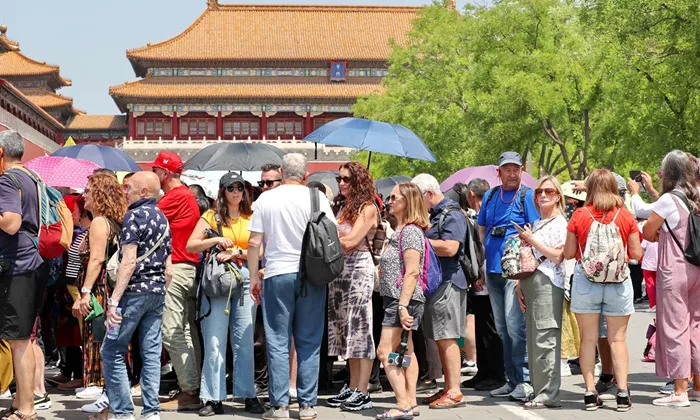“Be sure to bring an empty suitcase to China!” This practical tip has been spreading like wildfire on overseas social media recently, sparking enthusiastic discussions among netizens from various countries. When Dean from France set foot in China for the second time, he deliberately dragged a suitcase almost half his height. By the time he left Guanqian Street in Suzhou, it was stuffed with Hanfu, embroidered scarves, handmade tea sets, and the latest smartphones.
During the “May Day” holiday this year, Chinese shopping malls witnessed an unprecedented international consumption spree: the consumption amount of inbound tourists via Alipay soared by 180% year – on – year, and 48 tax – refund stores in Shanghai’s Qian滩 business district were packed with foreign faces on a shopping spree.
Policy Dividends Ignite Global Tourists’ Shopping Enthusiasm
Under the dual stimulus of the continuous relaxation of visa – free policies and the upgrade of tax – refund – on – departure services, China has implemented visa – free policies for citizens of 63 countries, opening its arms to welcome global tourists. Data from the National Immigration Administration shows that during the “May Day” holiday this year, 1.115 million foreigners entered and exited China, a sharp increase of 43.1% compared with the same period last year.
Among them, 380,000 foreigners entered the country under the visa – free policy, a year – on – year increase of 72.7%. Behind these numbers are the spontaneous trips to China by tourists from various countries.
The promotion of the “on – the – spot tax refund” service for tax – refund – on – departure across the country has become a key factor in igniting consumption. At Deji Plaza in Nanjing, Marino, an Italian tourist, received nearly 1,000 yuan in tax refunds “without leaving the store” after purchasing goods. “Just a few clicks on the phone and the money arrives. It’s super convenient.” Marino turned around and bought a set of pajamas. The tax – refund discount has stimulated his enthusiasm for secondary consumption.
Policy dividends have brought tangible economic benefits. In the first quarter of 2025, the sales of tax – refund goods in Beijing reached 270 million yuan, doubling year – on – year; in Shanghai, the sales of tax – refund goods were 760 million yuan, a year – on – year increase of 85%. These figures confirm that the policy combination is reshaping the global consumption landscape.
Shopping Lists: Transformation from Souvenirs to High – Tech Products
The shopping carts of foreign tourists are undergoing a qualitative change. At SKP, a high – end shopping mall in Beijing, staff observed that luxury goods, Chinese handicrafts, and electronic technology products have become the top three choices for foreign tourists, especially products from Huawei and DJI are highly favored.
Figg, a tourist from the United States, made a special trip to a DJI store to select a drone. He said frankly, “I visited China seven years ago, but the current tax – refund policy is much more convenient than it was then.”
Foreign tourists who once preferred small dolls and cheap souvenir shirts now pursue high – quality products with Chinese characteristics. On the shopping list of Dean, a French tourist, silk products, ceramics, and Hanfu occupy an important position, and smart products are a must – buy option.
Lawa, a clothing buyer from Guinea, shared his shopping list in Guangzhou on social media: rice – carving handicrafts, trendy – brand clothing, drones, tea… “The variety and scope of ‘Made in China’ are much wider than we imagined, and the quality is more reliable.” Lawa showed his spoils in the video.
The Rise of National Fashion: Cultural Confidence Leads a New Consumption Wave
In the Pingjiang Road Historic Block in Suzhou, tourists in Hanfu have become a moving scenery. Hanfu has created a new consumption market worth tens of billions of yuan, forming a complete industrial chain from fabric development to makeup and travel photography.
Zhong Jianmin, known as the “Hanfu Uncle,” with his solemn and elegant ancient costumes and a wide variety of men’s clothing in his store, enabled Sergio Gomez, a Cuban journalist from Xinhua News Agency, to complete his first experience of Hanfu.
This cultural promoter from a silk – merchant family said, “Hanfu carries thousands of years of traditional Chinese culture.”
The popularity of national fashion is extending from clothing to multiple fields. According to a report by iiMedia Research, the market size of China’s “national – fashion” economy reached 2.05 trillion yuan in 2023, a year – on – year increase of 9.44%, and is expected to exceed the 3 – trillion – yuan mark in 2028.
In Frankfurt, Germany, the Suxinqing Chinese Costume Culture Heritage Museum founded by Li Su, a post – 95 girl, displays nearly 500 exquisite Hanfu. She and her friends have participated in important festivals in many places in Germany wearing Hanfu, showing the cultural heritage of Oriental aesthetics to the local people.
Related Topics:
- UK Issues Balcony Safety Warning for Spain-Bound Tourists
- United Express Launches First Direct Flight from Redding to Denver
- Singapore Teams Up with iVIVU to Attract More Vietnamese Tourists

